May 18, 2020
Admin
8 min.
Lifestyle
Recipe for Dahi Vada Dahi Vada Recipe How to Make Dahi Vada
Disclosure : When you purchase a service or a product through our links, we sometimes earn a commission, at no extra cost to you.
Recipe for Dahi Vada - How to Make Dahi Vada at Home
Dahi Vada is a typical North Indian dish, which normally people take as a snack. Although Recipe of Dahi Vada is very simple to make but is very tasty to eat. In festivals like Diwali and Holi, many people make it at their own home. The taste also ensures that Dahi Vada Recipe is very popular among people managing Restaurants or even roadside eateries, where people savor its taste with great satisfaction.
The great taste of this dish has ensured that Recipe of Dahi Vada, is no longer prerogative of chefs in North Indian restaurants but Dahi Vada is now equally available in all parts of the country, from street-side Dhabas to five-star restaurants. The demand for Dahi Vada especially increases in the summer season.
Before we go further into Recipe for Dahi Vada or describe how to make Dahi Vada, it is important to mention what Dahi Vada consists of Vada (deep-fried balls made from ground pulses) which is submerged in Dahi (meaning curd).
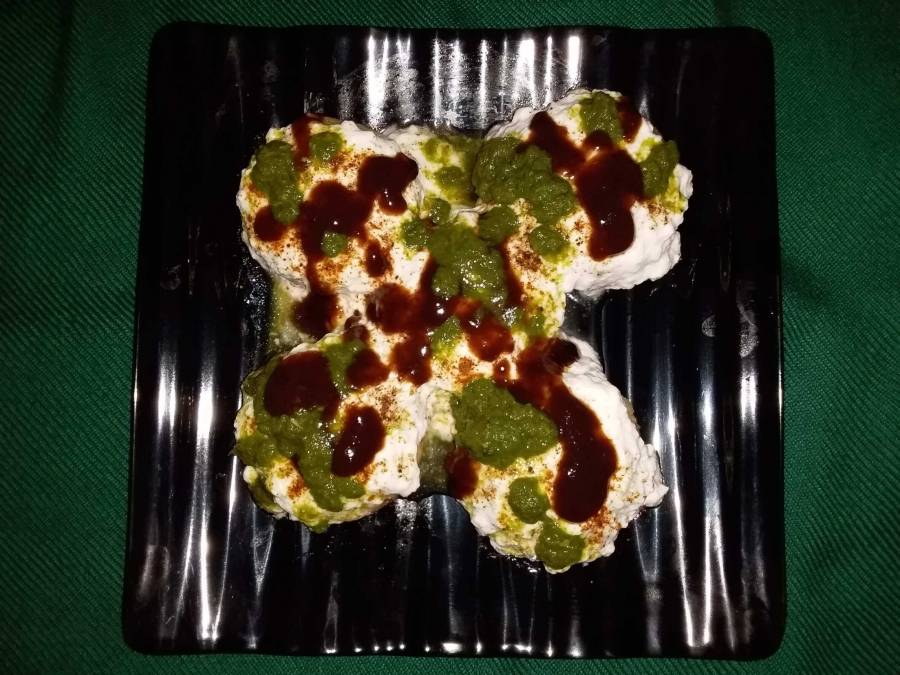
Dahi Vada is a very common Indian Snack.
For all those who want to know as – how to make Dahi Vada at home, the easy Dahi Vada Recipe described below would be very much useful, as it has been written, keeping in mind for those people who are new to Indian cooking. However, it is important to mention here that Recipe for Dahi Vada can be of North Indian variety and the second type is Recipe of Dahi Vada South Indian variety. The Dahi Vada Recipe discussed here is of the North Indian variety.
Ingredients Needed For Dahi Vada Recipe
A) Ingredients for Dahi Vada (For preparing Vada)
-
Urad Dal (Split & Dehusked Black Gram Lentils) – 200 grams
-
Onion – 2 in number (Medium size)
-
Salt – 1/4th teaspoon
-
Green Chilli – 1 in number (finely chopped)
-
Hing (Asafoetida) – 1/4th teaspoon
-
Ginger – ½ inch long
-
White edible oil – ½ cup
-
Cumin seeds – ½ teaspoon
-
Normal water – approximately 5 cups
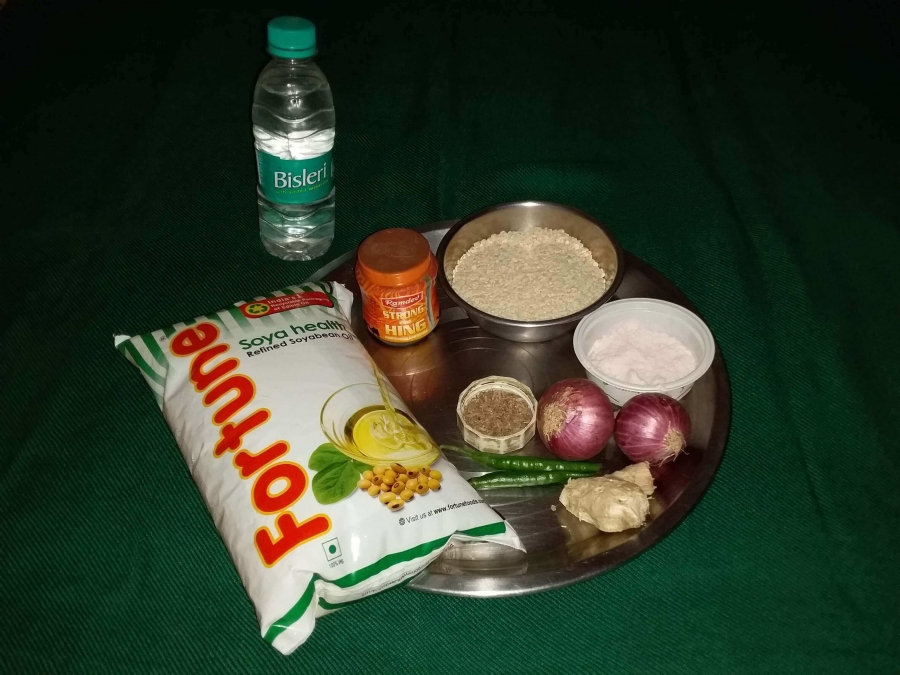
Ingredients needed for making Vada, in Recipe for Dahi Vada.
B) Ingredients for Dahi Vada (For Making Masala Powder Which is Sprinkled on Dahi Vada)
-
Black Salt – ½ teaspoon
-
Roasted Cumin Seeds – 1 teaspoon
-
Ajwain (Bishops weed) – ½ teaspoon
-
Chaat Masala Powder – 1 teaspoon
-
Black Pepper powder – ½ teaspoon
-
Red Chilli Powder (optional) – ½ teaspoon
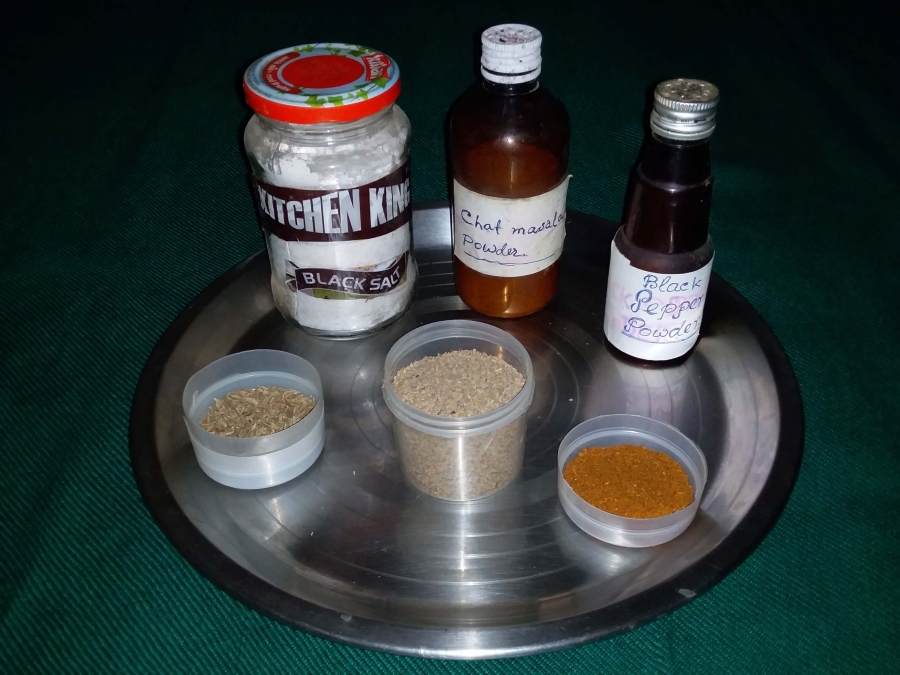
Ingredients for making masala powder, in Recipe of Dahi Vada.
C) Ingredients for Dahi Vada (Other Ingredients for Final Topping/Garnishing)
1) Curd – 2 cups
2) Tamarind Chutney – 1/4th cup (Ingredients to prepare this are described below)
-
Edible White Oil – ½ teaspoon
-
Tamarind – 50 grams
-
Jaggery – 100 grams
-
Dry Ginger Powder (Sounth powder) – 1 large pinch
-
Salt – Less than 1/4th teaspoon
-
Cumin seeds – 1/4th teaspoon
-
Chilli Powder – 1 large pinch
-
Fennel powder – 1/4th teaspoon
-
Water – 1/4th cup
3) Green Chutney – 1/4th cup (Ingredients to prepare this are described below)
-
Coriander Leaves – 50 grams
-
Pudina Leaves – 20 grams
-
Green Chilli – 1 in number
-
Black Salt - As per requirement/as per taste
-
Ginger – 1/4th inch
-
Lemon Juice – 1 teaspoon
-
Garlic Cloves – 2 in number
-
Cumin Seeds – 1/4th teaspoon
How to Make Dahi Vada at Home – The Steps in Dahi Vada Recipe
1) Making Vada in Recipe for Dahi Vada
-
Take Urad Dal (Split & dehusked Black gram lentils) in a deep vessel pan. Rinse it with water properly. Then soak it in adequate water for overnight or minimum for 4 to 5 hours. Keep in mind that the Dal should be always submerged under 4-inch water.
-
After the above mentioned time, drain out the water and transfer the soaked dal into a grinder. Put 6 to 7 tablespoons water into it & grind it and make a hard paste of ground dal. Take out the dal paste and transfer it into a bowl.
-
Cut onions into very fine and small pieces. Similarly cut ginger and green chili also very finely. Add these onion pieces, ginger & chili pieces to the dal paste along with Hing (Asafoetida) and cumin seeds. Mix all these nicely and beat the dal either by beater or by hand, till the dal mixture becomes fluffy.
-
Next, mix salt with the Dal and beat again till its consistency becomes smooth. However, always keep in mind that consistency should be smooth and not thin. So do not add too much water to the dal at the time of grinding.
-
For testing, if the Dal is ready for preparing Vada or not, check it by the method described below. Take a glass of water and take a very little mixture of dal and drop it into the glass with water, if the dal mixture floats on water, then it is now the right time to proceed for Vada preparation. But if the dal gets submerged into the water then it means that still more beating is required for the dal mixture. Only once the dal mixture passes this test, one should proceed to the next step.
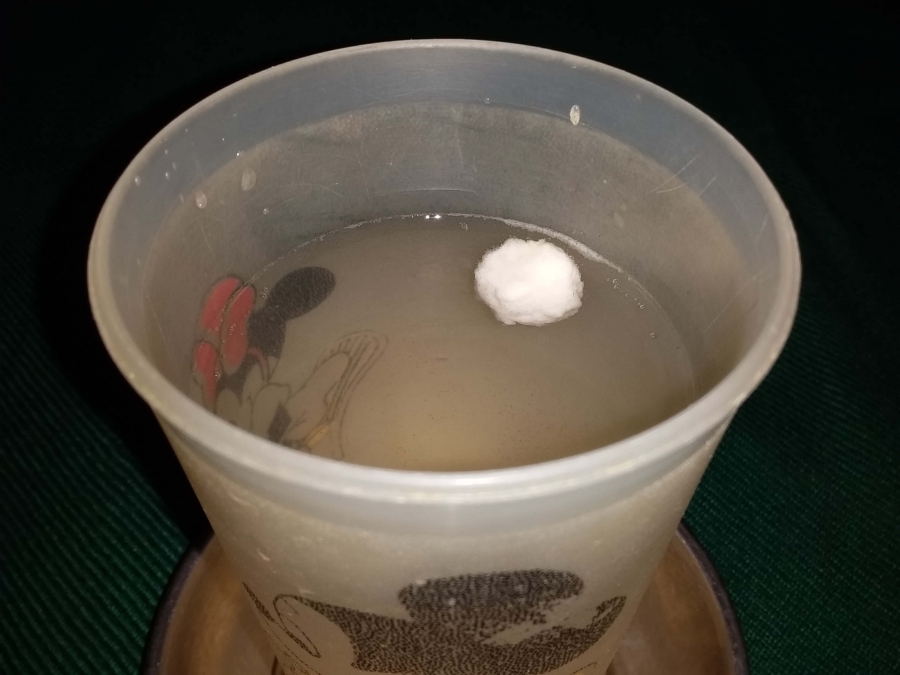
The Dal mixture should ideally float on water as described in Dahi Vada recipe.
-
Take a large bowl and fill up half of it with normal water and keep it aside.
-
Once the dal mixture has passed the above-described test then put a non-stick pan/karahi on a low medium flame burner and add oil into the pan and allow it to get warm.
-
Now rub little water to the palm of the left hand sufficient enough to keep it moist. Then take approximately 2 tablespoons Dal mixture on the moist palm. Lightly press it from the top by the fingers of the right hand and give a shape of a round flat ball.
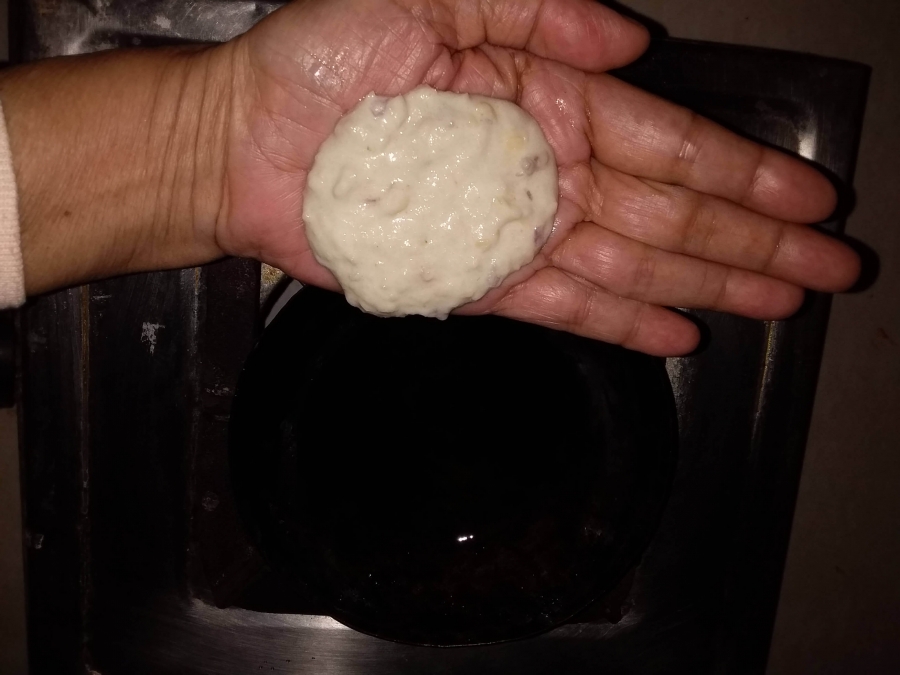
The raw Dal mixture before being fried, as described in Recipe for Dahi Vada.
-
Place this ball on the right hand by turning the left hand over the right hand and gently drop it in the hot oil. Fry it nicely from both sides.
-
Stir the Vada being prepared occasionally but very gently. Once it gets fried properly, it should attain a golden yellow color.
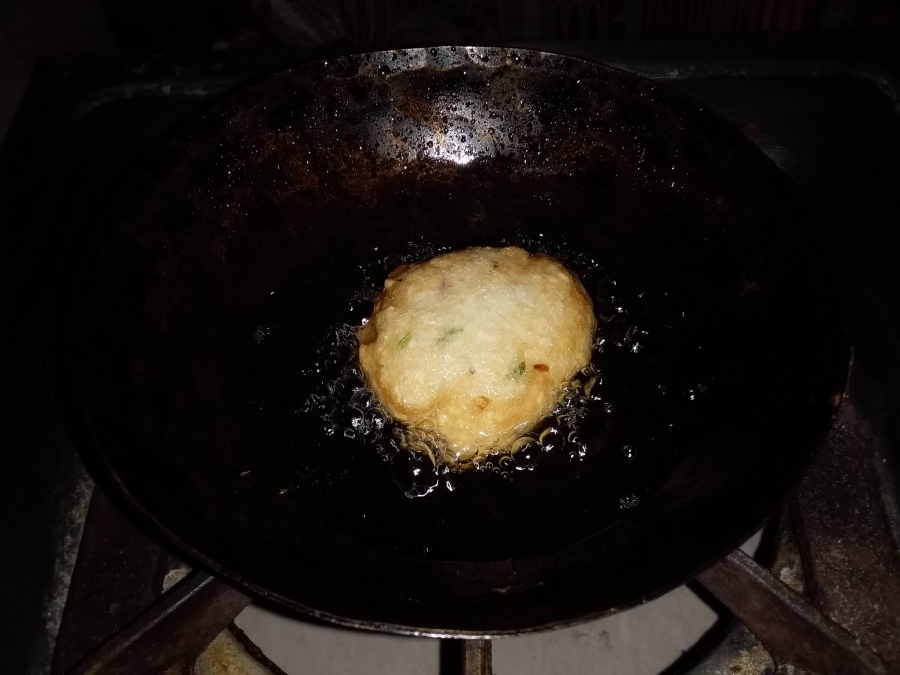
Vada being fried as described in Dahi Vada Recipe.
-
Later take it out and dip the hot fried Vada in the previously described bowl containing normal water.
-
Like this way fry multiple Vada (as much possible from dal mixture paste present) and later dip into the bowl containing normal water. Keep all this Vada prepared dipped into the water for 5 minutes.
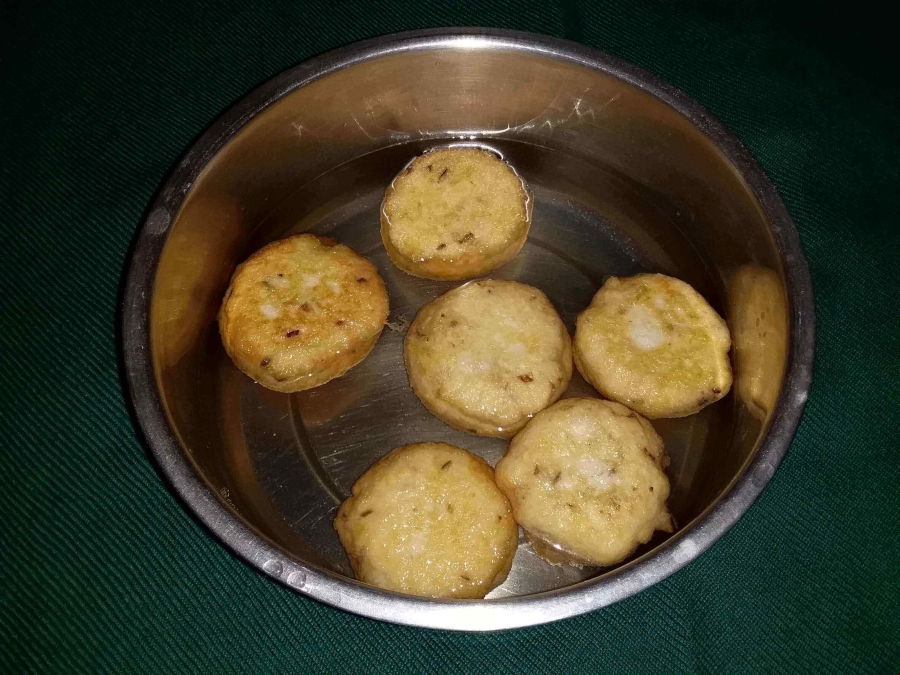
Fried Vada kept immersed in water as described in Recipe for Dahi Vada.
-
After 5 minutes take the Vada out from water one by one & press them gently between 2 palms, so the extra water contained in it will come out. Later arrange nicely these Vadas, with water drained, in a plate properly.
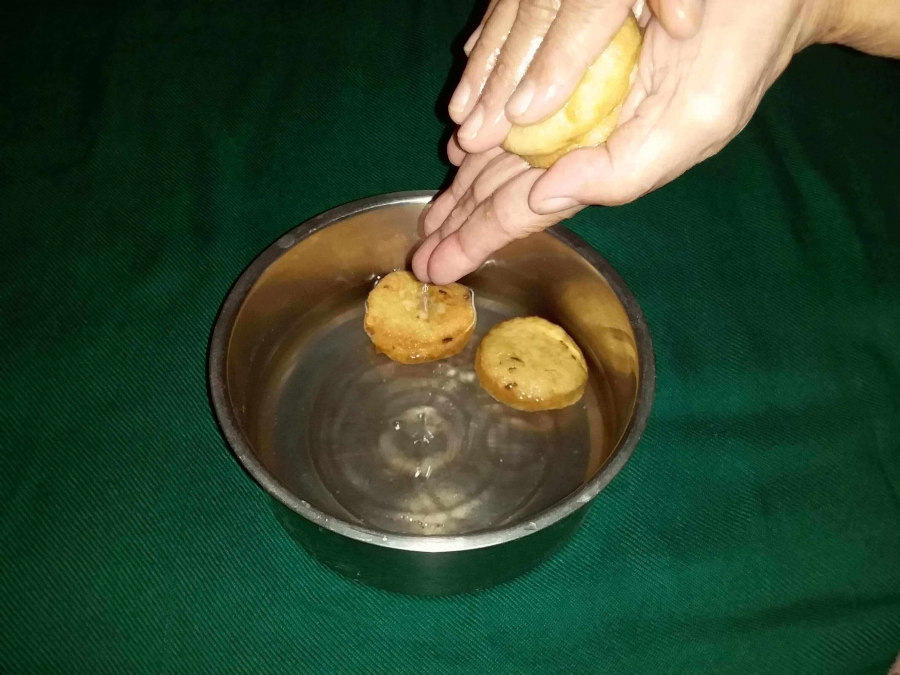
Pressing out the extra water from Vada, as described in Recipe of Dahi Vada.
-
Now the curd is beaten thoroughly after keeping it in a bowl. Next pour this beaten curd, from the top on all the prepared Vada arranged in the plate. It should be ensured that all sides of the Vada are fully covered by curd.
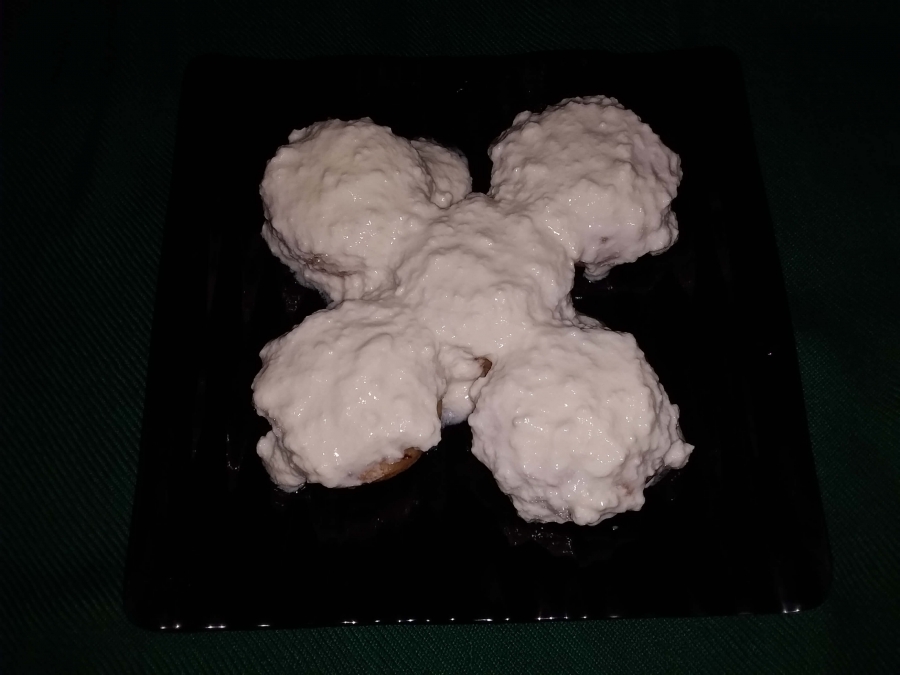
Vada covered by Dahi, as described in Dahi Vada Recipe.
2) Preparing Masala Powder in Recipe of Dahi Vada (For Garnishing Purposes)
-
Now for preparing the Masala powder, grind all ingredients described above in - Ingredients for Dahi Vada (For Making Masala Powder Which is Sprinkled on Dahi Vada). If anyone likes too much chili in their food then Chili powder, which is written in the chart, may be added, however, this is optional. Otherwise, make a powder from the other ingredients (excluding the chili) and sprinkle this masala powder on the top of Dahi Vada.
3) Dahi Vada Chutney Recipe (Tamarind Chutney)
-
In a pan put Tamarind (whole), Jaggery & water together. Now place this pan in a medium flame burner. Let it boil for 2 to 3 minutes, and then switch off the burner & cover the pan for 10 minutes. Then open the lid of the pan and let it cool at room temperature.
-
Next, mash the Tamarind by hand and just keep its pulp and discard the seeds and other residues.
-
Now put another pan on a low medium flame burner. Add oil in it and let it get warmed. Once the oil is hot then put cumin seeds in it. When cumin seeds start spluttering then add Tamarind pulp and Jaggery mixture (mentioned previously) in it. Stir nicely and add salt, dry ginger powder, chili powder, fennel powder all together & when it starts to boil and becomes thick, then switch off the burner and transfer the contents to a bowl and wait for its cooling.
-
Tamarind Chutney is ready now.
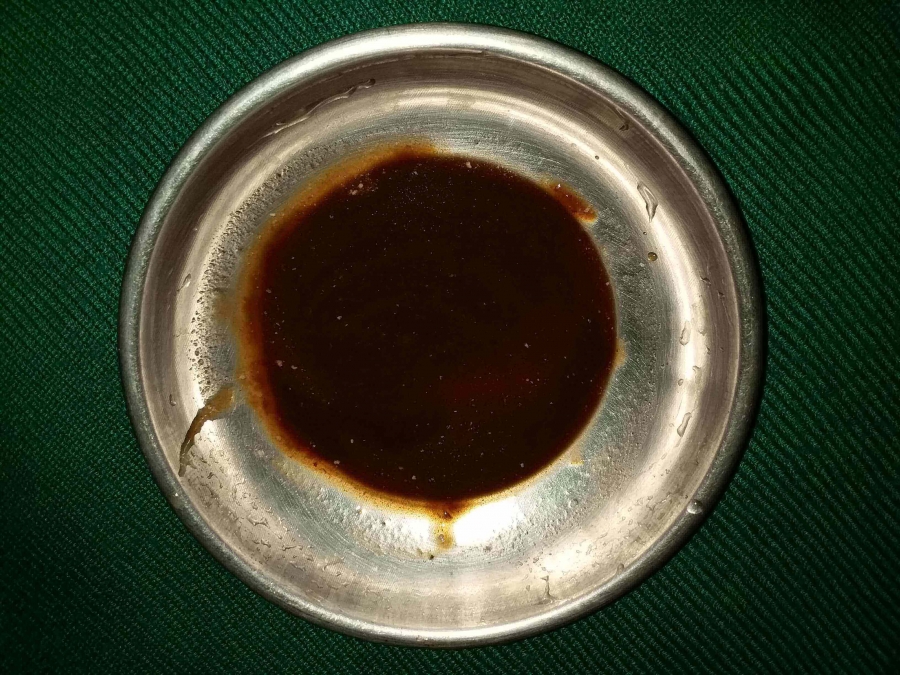
Tamarind Chutney as described in Dahi Vada Chutney Recipe.
4) Dahi Vada Chutney Recipe (Green Chutney)
-
Wash Coriander leaves and Pudina leaves nicely by water, then put all the ingredients previously mentioned above in the ingredients list into a grinder and grind it without adding water and make a smooth paste.
-
Later take out the above preparation from the grinder. Green Chutney is ready now.
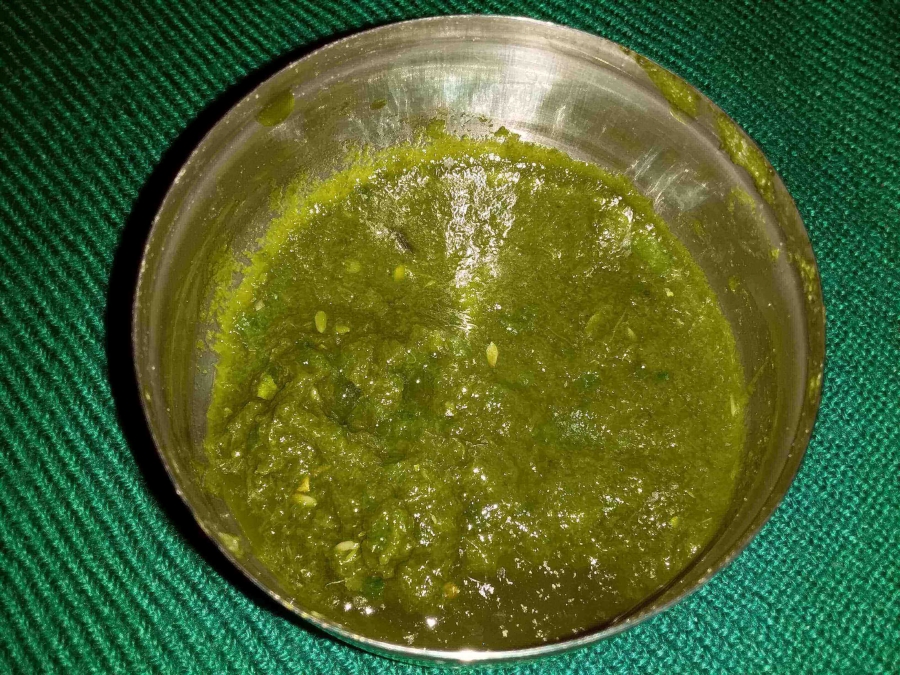
Green Chutney as described in Dahi Vada Chutney Recipe.
5) Final Step of Garnishing in Dahi Vada Recipe
-
The final step of the Recipe for Dahi Vada consists of spreading the Green Chutney & Tamarind Chutney on the top of each Dahi Vada.
-
Dahi Vada is now ready to be served to your friends and family members.
-
Hopefully, Recipe of Dahi Vada in English described here would help all those, who wanted to know as to how to make Dahi Vada at home.
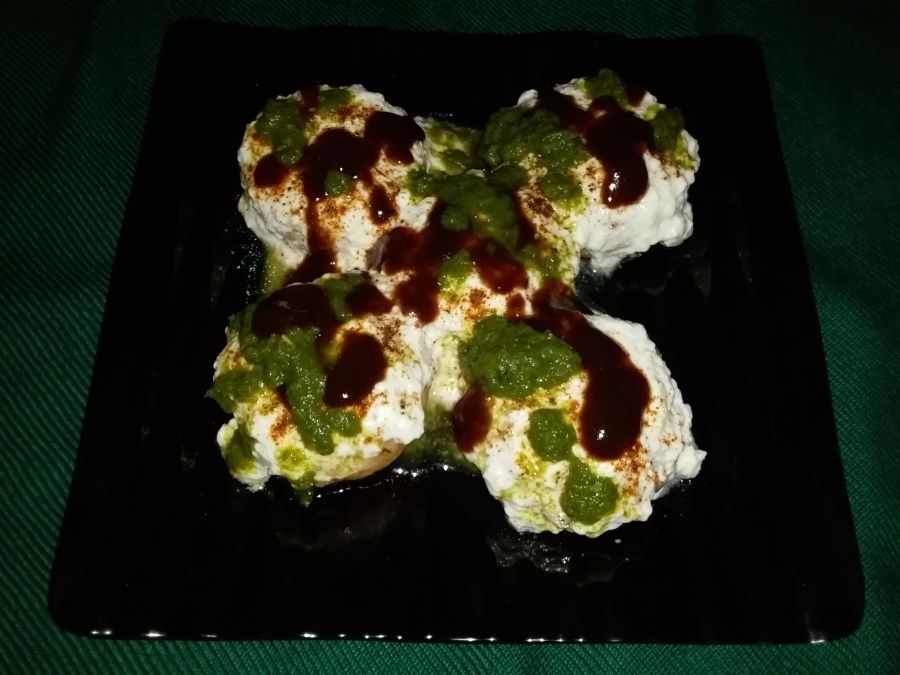
Dahi Vada - The final dish prepared by Dahi Vada Recipe.
(DECLARATION - All the images used in this site, are either from personal collection, or are images available in Public Domain. The owner of this website is grateful to all those, who donated their images to – Wikipedia, Wikimedia, Flickr, Pixabay, Picryl and all other sites; for free use, as images in Public Domain.)
Disclosure: When you purchase a service or a product through our links, we sometimes earn a commission, at no extra cost to you.










